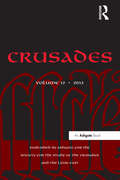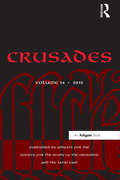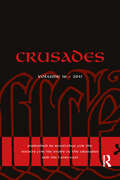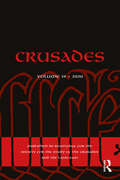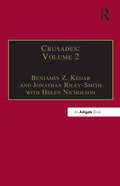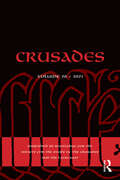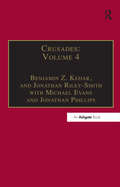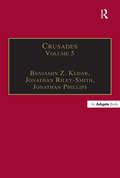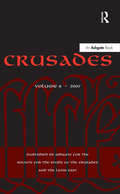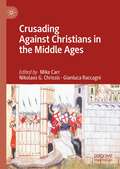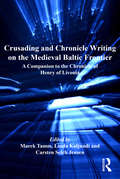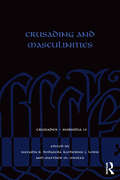- Table View
- List View
Crusades: Volume 12 (Crusades)
by Jonathan Riley-Smith Jonathan Phillips Benjamin Z. KedarCrusades covers seven hundred years from the First Crusade (1095-1102) to the fall of Malta (1798) and draws together scholars working on theatres of war, their home fronts and settlements from the Baltic to Africa and from Spain to the Near East and on theology, law, literature, art, numismatics and economic, social, political and military history. Routledge publishes this journal for The Society for the Study of the Crusades and the Latin East. Particular attention is given to the publication of historical sources in all relevant languages - narrative, homiletic and documentary - in trustworthy editions, but studies and interpretative essays are welcomed too. Crusades appears in both print and online editions.
Crusades: Volume 13 (Crusades)
by Jonathan Riley-Smith Jonathan Phillips Benjamin Z. KedarCrusades covers seven hundred years from the First Crusade (1095-1102) to the fall of Malta (1798) and draws together scholars working on theatres of war, their home fronts and settlements from the Baltic to Africa and from Spain to the Near East and on theology, law, literature, art, numismatics and economic, social, political and military history. Routledge publishes this journal for The Society for the Study of the Crusades and the Latin East. Particular attention is given to the publication of historical sources in all relevant languages - narrative, homiletic and documentary - in trustworthy editions, but studies and interpretative essays are welcomed too. Crusades appears in both print and online editions.
Crusades: Volume 14 (Crusades)
by Jonathan Riley-Smith Jonathan Phillips Benjamin Z. KedarCrusades covers seven hundred years from the First Crusade (1095-1102) to the fall of Malta (1798) and draws together scholars working on theatres of war, their home fronts and settlements from the Baltic to Africa and from Spain to the Near East and on theology, law, literature, art, numismatics and economic, social, political and military history. Routledge publishes this journal for The Society for the Study of the Crusades and the Latin East. Particular attention is given to the publication of historical sources in all relevant languages - narrative, homiletic and documentary - in trustworthy editions, but studies and interpretative essays are welcomed too. Crusades appears in both print and online editions.
Crusades: Volume 15 (Crusades)
by Jonathan Riley-Smith Jonathan Phillips Benjamin Z. Kedar Nikolaos G. ChrissisCrusades covers seven hundred years from the First Crusade (1095-1102) to the fall of Malta (1798) and draws together scholars working on theatres of war, their home fronts and settlements from the Baltic to Africa and from Spain to the Near East and on theology, law, literature, art, numismatics and economic, social, political and military history. Routledge publishes this journal for The Society for the Study of the Crusades and the Latin East. Particular attention is given to the publication of historical sources in all relevant languages - narrative, homiletic and documentary - in trustworthy editions, but studies and interpretative essays are welcomed too. Crusades also incorporates the Society's Bulletin.
Crusades: Volume 16 (Crusades)
by Jonathan Phillips Benjamin Z. Kedar Nikolaos G. ChrissisCrusades covers seven hundred years from the First Crusade (1095-1102) to the fall of Malta (1798) and draws together scholars working on theatres of war, their home fronts and settlements from the Baltic to Africa and from Spain to the Near East and on theology, law, literature, art, numismatics and economic, social, political and military history. Routledge publishes this journal for The Society for the Study of the Crusades and the Latin East. Particular attention is given to the publication of historical sources in all relevant languages - narrative, homiletic and documentary - in trustworthy editions, but studies and interpretative essays are welcomed too. Crusades also incorporates the Society's Bulletin.
Crusades: Volume 17 (Crusades)
by Jonathan Phillips Benjamin Z. KedarCrusades covers seven hundred years from the First Crusade (1095–1102) to the fall of Malta (1798) and draws together scholars working on theatres of war, their home fronts and settlements from the Baltic to Africa and from Spain to the Near East and on theology, law, literature, art, numismatics and economic, social, political and military history. Routledge publishes this journal for The Society for the Study of the Crusades and the Latin East. Particular attention is given to the publication of historical sources in all relevant languages – narrative, homiletic and documentary - in trustworthy editions, but studies and interpretative essays are welcomed too. Crusades also incorporates the Society's Bulletin. The editors are Benjamin Z. Kedar, Hebrew University, Israel; Jonathan Phillips, Royal Holloway, University of London, UK; Nikolaos G. Chrissis, Democritus University of Thrace, Greece.
Crusades: Volume 18 (Crusades)
by Jonathan Phillips Benjamin Z. Kedar Nikolaos G. Chrissis Iris ShagrirCrusades covers the seven hundred years from the First Crusade (1095-1102) to the fall of Malta (1798) and draws together scholars working on theatres of war, their home fronts and settlements from the Baltic to Africa and from Spain to the Near East and on theology, law, literature, art, numismatics and economic, social, political and military history. Routledge publishes this journal for The Society for the Study of the Crusades and the Latin East. Particular attention is given to the publication of historical sources - narrative, homiletic and documentary - but studies and interpretative essays are welcomed too. Crusades also incorporates the Society's Bulletin. The editors are Professor Benjamin Z. Kedar, Hebrew University of Jerusalem, Israel; Professor Jonathan Phillips, Royal Holloway, University of London, UK; Iris Shagrir, The Open University of Israel; and Nikolaos G. Chrissis, Democritus University of Thrace, Greece.
Crusades: Volume 19 (Crusades)
by Benjamin Z. Kedar; Jonathan Phillips; Nikolaos G. Chrissis; Iris ShagrirCrusades covers the seven hundred years from the First Crusade (1095-1102) to the fall of Malta (1798) and draws together scholars working on theatres of war, their home fronts and settlements from the Baltic to Africa and from Spain to the Near East and on theology, law, literature, art, numismatics and economic, social, political and military history. Routledge publishes this journal for The Society for the Study of the Crusades and the Latin East. Particular attention is given to the publication of historical sources - narrative, homiletic and documentary - but studies and interpretative essays are welcomed too. Crusades also incorporates the Society's Bulletin. The editors are Professor Benjamin Z. Kedar, Hebrew University of Jerusalem, Israel; Professor Jonathan Phillips, Royal Holloway, University of London, UK; Nikolaos G. Chrissis, Democritus University of Thrace, Greece; and Iris Shagrir, The Open University of Israel.
Crusades: Volume 2 (Crusades #13)
by Jonathan Riley-Smith Jonathan Phillips Benjamin Z. KedarCrusades covers seven hundred years from the First Crusade (1095-1102) to the fall of Malta (1798) and draws together scholars working on theatres of war, their home fronts and settlements from the Baltic to Africa and from Spain to the Near East and on theology, law, literature, art, numismatics and economic, social, political and military history. Routledge publishes this journal for The Society for the Study of the Crusades and the Latin East. Particular attention is given to the publication of historical sources in all relevant languages - narrative, homiletic and documentary - in trustworthy editions, but studies and interpretative essays are welcomed too. Crusades appears in both print and online editions. Issue 2 of the Crusades includes Jonathan Riley-Smith's 'survey of Islam and the Crusades in history and imagination, over the course of the twentieth century culminating in the aftermath of the 9/11 attacks.
Crusades: Volume 20 (Crusades)
by Society for the Study of the Crusades and the Latin EastCrusades covers the seven hundred years from the First Crusade (1095-1102) to the fall of Malta (1798) and draws together scholars working on theatres of war, their home fronts and settlements from the Baltic to Africa and from Spain to the Near East and on theology, law, literature, art, numismatics and economic, social, political and military history. Routledge publishes this journal for The Society for the Study of the Crusades and the Latin East. Particular attention is given to the publication of historical sources - narrative, homiletic and documentary - but studies and interpretative essays are welcomed too. Crusades also incorporates the Society's Bulletin. The editors are Professor Benjamin Z. Kedar, Hebrew University of Jerusalem, Israel; Professor Jonathan Phillips, Royal Holloway, University of London, UK; Nikolaos G. Chrissis, Democritus University of Thrace, Greece; and Iris Shagrir, The Open University of Israel.
Crusades: Volume 21 (Crusades)
by Jonathan Phillips Benjamin Z. Kedar Nikolaos G. Chrissis Iris ShagrirCrusades covers the seven hundred years from the First Crusade (1095-1102) to the fall of Malta (1798) and draws together scholars working on theatres of war, their home fronts and settlements from the Baltic to Africa and from Spain to the Near East and on theology, law, literature, art, numismatics and economic, social, political and military history. Routledge publishes this journal for The Society for the Study of the Crusades and the Latin East. Particular attention is given to the publication of historical sources - narrative, homiletic and documentary - but studies and interpretative essays are welcomed too. Crusades also incorporates the Society's Bulletin. The editors are Professor Jonathan Phillips, Royal Holloway, University of London, UK; Iris Shagrir, The Open University of Israel; Professor Benjamin Z. Kedar, Hebrew University of Jerusalem, Israel; and Nikolaos G. Chrissis, Democritus University of Thrace, Greece.
Crusades: Volume 3 (Crusades #13)
by Jonathan Riley-Smith Jonathan Phillips Benjamin Z. KedarCrusades covers seven hundred years from the First Crusade (1095-1102) to the fall of Malta (1798) and draws together scholars working on theatres of war, their home fronts and settlements from the Baltic to Africa and from Spain to the Near East and on theology, law, literature, art, numismatics and economic, social, political and military history. Routledge publishes this journal for The Society for the Study of the Crusades and the Latin East. Particular attention is given to the publication of historical sources in all relevant languages - narrative, homiletic and documentary - in trustworthy editions, but studies and interpretative essays are welcomed too. Crusades appears in both print and online editions. The third issue of the Crusades features articles from Denys Pringle on Crusader inscriptions, Bejamin Z. Kadar on the massacre of 15 July 1099 and Peter Frankopan on co-operation between Constantinople and Rome before the First Crusade.
Crusades: Volume 4 (Crusades)
by Jonathan Riley-Smith Jonathan Phillips Benjamin Z. KedarCrusades covers seven hundred years from the First Crusade (1095-1102) to the fall of Malta (1798) and draws together scholars working on theatres of war, their home fronts and settlements from the Baltic to Africa and from Spain to the Near East and on theology, law, literature, art, numismatics and economic, social, political and military history. Routledge publishes this journal for The Society for the Study of the Crusades and the Latin East. Particular attention is given to the publication of historical sources in all relevant languages - narrative, homiletic and documentary - in trustworthy editions, but studies and interpretative essays are welcomed too. Crusades appears in both print and online editions. Issue 4 of Crusades kicks off with Graham Loud's reflections on the failure of the Second Crusade and also features Susan Edgington's administrative regulations for the Hospital of St John in Jerusalem dating from the 1180s.
Crusades: Volume 5 (Crusades)
by Jonathan Riley-Smith Jonathan Phillips Benjamin Z. KedarCrusades covers seven hundred years from the First Crusade (1095-1102) to the fall of Malta (1798) and draws together scholars working on theatres of war, their home fronts and settlements from the Baltic to Africa and from Spain to the Near East and on theology, law, literature, art, numismatics and economic, social, political and military history. Routledge publishes this journal for The Society for the Study of the Crusades and the Latin East. Particular attention is given to the publication of historical sources in all relevant languages - narrative, homiletic and documentary - in trustworthy editions, but studies and interpretative essays are welcomed too. Crusades appears in both print and online editions. Volume 5 is notable for John's France's article, 'Two types of vision on the First Crusade: Stephen of Valence and Peter Bartholomew'.
Crusades: Volume 6 (Crusades)
by Jonathan Riley-Smith Jonathan Phillips Benjamin Z. KedarCrusades covers seven hundred years from the First Crusade (1095-1102) to the fall of Malta (1798) and draws together scholars working on theatres of war, their home fronts and settlements from the Baltic to Africa and from Spain to the Near East and on theology, law, literature, art, numismatics and economic, social, political and military history. Routledge publishes this journal for The Society for the Study of the Crusades and the Latin East. Particular attention is given to the publication of historical sources in all relevant languages - narrative, homiletic and documentary - in trustworthy editions, but studies and interpretative essays are welcomed too. Crusades appears in both print and online editions. Peter W. Edbury again features in an issue of Crusades, this time with his piece on The French translation of William of Tyre's Historia: the manuscript tradition.
Crusades: Volume 7 (Crusades)
by Jonathan Riley-Smith Jonathan Phillips Benjamin Z. KedarCrusades covers seven hundred years from the First Crusade (1095-1102) to the fall of Malta (1798) and draws together scholars working on theatres of war, their home fronts and settlements from the Baltic to Africa and from Spain to the Near East and on theology, law, literature, art, numismatics and economic, social, political and military history. Routledge publishes this journal for The Society for the Study of the Crusades and the Latin East. Particular attention is given to the publication of historical sources in all relevant languages - narrative, homiletic and documentary - in trustworthy editions, but studies and interpretative essays are welcomed too. Crusades appears in both print and online editions. In this issue, Jonathan Riley-Smith studies the death and burial of Latin Christian pilgrims to Jerusalem and Acre and Andrew Jotischky studies the Christians of Jerusalem, the Holy Sepulchre and the origins of the First Crusade.
Crusades: Volume 8 (Crusades)
by Jonathan Riley-Smith Jonathan Phillips Benjamin Z. KedarCrusades covers seven hundred years from the First Crusade (1095-1102) to the fall of Malta (1798) and draws together scholars working on theatres of war, their home fronts and settlements from the Baltic to Africa and from Spain to the Near East and on theology, law, literature, art, numismatics and economic, social, political and military history. Routledge publishes this journal for The Society for the Study of the Crusades and the Latin East. Particular attention is given to the publication of historical sources in all relevant languages - narrative, homiletic and documentary - in trustworthy editions, but studies and interpretative essays are welcomed too. Crusades appears in both print and online editions. Volume 8 begins with Adrian J. Boas and Aren M. Maeir on the Frankish Castle of Blanche Garde and the Medieval and Modern Village of Tell es-Safi in the light of recent discoveries.
Crusades: Volume 9 (Crusades)
by Jonathan Riley-Smith Jonathan Phillips Benjamin Z. KedarCrusades covers seven hundred years from the First Crusade (1095-1102) to the fall of Malta (1798) and draws together scholars working on theatres of war, their home fronts and settlements from the Baltic to Africa and from Spain to the Near East and on theology, law, literature, art, numismatics and economic, social, political and military history. Routledge publishes this journal for The Society for the Study of the Crusades and the Latin East. Particular attention is given to the publication of historical sources in all relevant languages - narrative, homiletic and documentary - in trustworthy editions, but studies and interpretative essays are welcomed too. Crusades appears in both print and online editions.
Crusading Against Christians in the Middle Ages
by Nikolaos G. Chrissis Mike Carr Gianluca RaccagniThis is the first book-length study into crusading against Christians, examining this complex phenomenon from the twelfth to fifteenth centuries and across numerous regions, from France to Russia and from southern Italy to the Baltic. Whilst the crusades are an immensely popular topic, those launched against Christian rulers and communities have been comparatively overlooked in the past, with existing studies typically focusing on a particular area, period, or campaign. This volume brings together the expertise of thirteen scholars on a variety of primary and secondary sources not often accessible to Anglophone readership, as well as their knowledge of national discourses which have often shaped historiography. It aims to serve as the first port of call for anyone who wishes to approach crusades against Christians within and without the specialism of crusader studies, and to provide the basis for a thorough comparative analysis of this phenomenon, covering its variety as comprehensively as possible.
Crusading Iowa Journalist Verne Marshall: Exposing Graft and the 1936 Pulitzer Prize
by Jerry HarringtonOn December 12, 1934, police raided a canning factory in Cedar Rapids, uncovering an illegal liquor and gambling set-up. Verne Marshall, tempestuous editor of the Cedar Rapids Gazette, sensed a bigger story and a wider network of corruption. His aggressive investigative reporting led to multiple resignations, nearly fifty indictments and the dramatic trial of the state's attorney general. These explosive exposés earned Verne Marshall and the paper the 1936 Pulitzer Prize. Author Jerry Harrington traces the legacy of Marshall's incendiary crusade across Iowa's political landscape.
Crusading and Archaeology: Some Archaeological Approaches to the Crusades (Crusades - Subsidia)
by Shotten-Hallel, Vardit R.Between the eleventh and fifteenth centuries, the social and cultural worlds of medieval Europe and the Eastern Mediterranean were transformed by the religious impetus of the crusades. Today we bear witness to these transformations in the material and environmental record revealed by new archaeological excavations and reappraisals of museum collections. This volume highlights new archaeological knowledge being developed by scholars working in the fields of history, archaeology, numismatics, and architecture to demonstrate its potential to change and augment our understanding of the crusades. The 16 chapters in this volume deploy a contemporary scientific approach to archaeology of the crusades to give an up-to-date account into the diverse range of research in this area. They explore five key themes: the implications of scientific methods, new excavations and surveys, architectural analyses, sigillography, and the application of social interpretations. Together these chapters provide a new way of approaching the study of the crusades, and demonstrate the value of taking a holistic view that utilises the full diverse range of evidence available to us.
Crusading and Chronicle Writing on the Medieval Baltic Frontier: A Companion to the Chronicle of Henry of Livonia
by Marek Tamm Linda Kaljundi Carsten Selch JensenThe Chronicle of Henry of Livonia, written by a missionary priest in the early thirteenth century to record the history of the crusades to Livonia and Estonia around 1186-1227, offers one of the most vivid examples of the early thirteenth century crusading ideology in practice. Step by step, it has become one of the most widely read and acknowledged frontier crusading and missionary chronicles. Henry's chronicle offers many opportunities to test and broaden the new approaches and key concepts brought along by recent developments in medieval studies, including the new pluralist definition of crusading and the relationship between the peripheries and core areas of Europe. While recent years have produced a significant amount of new research into Henry of Livonia, much of it has been limited to particular historical traditions and languages. A key objective of this book, therefore, is to synthesise the current state of research for the international scholarly audience. The volume provides a multi-sided and multi-disciplinary companion to the chronicle, and is divided into three parts. The first part, 'Representations,' brings into focus the imaginary sphere of the chronicle - the various images brought into existence by the amalgamation of crusading and missionary ideology and the frontier experience. This is followed by studies on 'Practices,' which examines the chronicle's reflections of the diplomatic, religious, and military practices of the christianisation and colonisation processes in medieval Livonia. The volume concludes with a section on the 'Appropriations,' which maps the reception history of the chronicle: the dynamics of the medieval, early modern and modern national uses and abuses of the text.
Crusading and Masculinities (Crusades - Subsidia #13)
by Matthew Mesley Natasha Hodgson Katherine LewisThis volume presents the first substantial exploration of crusading and masculinity, focusing on the varied ways in which the symbiotic relationship between the two was made manifest in a range of medieval settings and sources, and to what ends. Ideas about masculinity formed an inherent part of the mindset of societies in which crusading happened, and of the conceptual framework informing both those who recorded the events and those who participated. Examination and interrogation of these ideas enables a better contextualised analysis of how those events were experienced, comprehended and portrayed. The collection is structured around five themes: sources and models; contrasting masculinities; emasculation and transgression; masculinity and religiosity and kingship and chivalry. By incorporating masculinity within their analysis of the crusades and of crusaders the contributors demonstrate how such approaches greatly enhance our understanding of crusading as an ideal, an institution and an experience. Individual essays consider western campaigns to the Middle East and Islamic responses; events and sources from the Iberian peninsula and Prussia are also interrogated and re-examined, thus enabling cross-cultural comparison of the meanings attached to medieval manhood. The collection also highlights the value of employing gender as a vital means of assessing relationships between different groups of men, whose values and standards of behaviour were socially and culturally constructed in distinct ways.
Crusading and Trading between West and East: Studies in Honour of David Jacoby (Crusades - Subsidia)
by Benjamin Z. Kedar Sophia Menache Michel BalardFor almost sixty years Professor David Jacoby devoted his research to the economic, social and cultural history of the Eastern Mediterranean and this new collection reflects his impact on the study of the interactions between the Italian city-states, Byzantium, the Latin East and the realm of Islam. Contributors to this volume are prominent scholars from across Medieval Studies and leading historians of the younger generation.
Crusading and Warfare in Medieval and Renaissance Europe (Variorum Collected Studies)
by Norman HousleyThese studies span the period from the origins of the crusading movement in the 11th century until its final active phase during the Renaissance. Some of the articles spring from Norman Housley’s work on crusading against Christian heretics, mercenary companies and lay powers which were involved in conflict with the Church. Others reflect his interest in the way crusading developed after the fall of the Holy Land to the Muslims in 1291. A third group looks at other forms taken by religious warfare in Europe during the late Middle Ages and Renaissance. Certain themes recur throughout. One is the variety of ways in which war in God’s name was portrayed and justified. Another is the conflict of interest brought about by the diversity of crusading in the period from c.1200 onwards. Above all, the author shows the complexity, longevity and significance of a movement whose impact on medieval society was massive and whose repercussions were profound.
